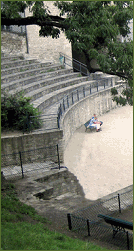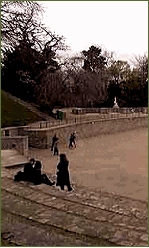|
The Paris amphitheatre is thought to have been the largest of its
kind constructed by the Romans and had a sunken arena surrounded by the wall of a podium,
which was about 2.5 metre high, plus had a stage that was approximately 41.2 metres
long. There were a series of nine niches that aided in improving the acoustics along
with five cubbyholes situated beneath the lower stands. Three of these appear to
have been animal cages that opened directly into the arena and historians believe that the
tiered stands, which surrounded more than half of the arena's circumference, could
accommodate as many as 17,000 spectators at any one time.
Unfortunately, during the barbaric invasions of 280 AD some of the amphitheatres stone
work was carted off to reinforce the city's defences around Ile de la Cit?, then it
became a cemetery and then it was filled in following the construction of Philippe
Auguste's walls in the 13th century.
But centuries later, it was re-discovered by Theodore Vaquer during the building of the
Rue Monge between 1860 and 1869 and the author Victor
Hugo along with some other intellectuals decided to save this archaeological site and
set up the preservation committee called la Soci?t? des Amis des Ar?nes.
After the demolition of the Couvent des Filles de J?sus-Christ in 1883 around a third of
the arena was uncovered and then the council dedicated funds to restoring the arena and
decided to make it a public square, which was opened in 1896.
Jean-Louis Capitan, who was a doctor and anthropologist, decided to continue with the
excavation of the Arenes de Lutece after the tramway lines and depot were dismantled in
1916 and the neighbouring square, Capitan, is dedicated to his memory.
However, there is still a portion of the original arena that was opposite the stage, which
is lost due to the buildings that line Rue Monge, but standing in the centre of the arena
you can still observe significant remnants of the stage and its nine niches, as well as
the grilled cages in the walls.
The tiered stands are not the originals, but it gives you a greater feel of how the Arenes
de Lutece would have been and the open seating of this arena is backed by banks of grass,
trees and a peaceful garden.
A great place to visit on a nice warm day, there are lots of tucked-away places to sit
with a book or enjoy a family picnic and you will often see people playing the old game of
petanque or boules, etc.
The Arenes de Lutece is accessible by three different entrances. The first is a passageway
through the building at 47 Rue Monge, the second is an open corridor accessible from rue
de Navarre through a gate and the third is through the Square Capitan from its entrance at
10 Rue des Ar?nes.
This very popular but tranquil haven of peace from the hustle of Paris is open from 8am
through to 5.30pm in winter and 10pm in summer months.
Address & Contact Details:
Ar?nes de Lut?ce
47 Rue Monge et Rue de Navarre
75005
Paris
France
|
|



